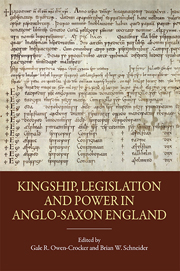Book contents
- Frontmatter
- Contents
- List of Illustrations
- List of Tables
- Contributors
- Preface
- Abbreviations
- Introduction
- PART I
- PART II
- 2 Anglo-Saxon Royal Archives: Their Nature, Extent, Survival and Loss
- 3 Naming and Royal Authority in Anglo-Saxon Law
- 4 Witnessing Kingship: Royal Power and the Legal Subject in the Old English Laws
- 5 The Burial of Kings in Anglo-Saxon England
- 6 Ine 70.1 and Royal Provision in Anglo-Saxon Wessex
- 7 Being Everywhere at Once: Delegation and Royal Authority in Late Anglo-Saxon England
- Index of persons and places
3 - Naming and Royal Authority in Anglo-Saxon Law
from PART II
Published online by Cambridge University Press: 05 December 2013
- Frontmatter
- Contents
- List of Illustrations
- List of Tables
- Contributors
- Preface
- Abbreviations
- Introduction
- PART I
- PART II
- 2 Anglo-Saxon Royal Archives: Their Nature, Extent, Survival and Loss
- 3 Naming and Royal Authority in Anglo-Saxon Law
- 4 Witnessing Kingship: Royal Power and the Legal Subject in the Old English Laws
- 5 The Burial of Kings in Anglo-Saxon England
- 6 Ine 70.1 and Royal Provision in Anglo-Saxon Wessex
- 7 Being Everywhere at Once: Delegation and Royal Authority in Late Anglo-Saxon England
- Index of persons and places
Summary
Kings and Laws
Throughout most of the period from which documentary records survive. Anglo-Saxon kingship is closely associated with law-giving. The earliest text in Old English is the law-code issued by Æthelberht I of Kent (c. 580–616) towards the end of the sixth or the beginning of the seventh century, inaugurating a tradition of written legislation which continued up until the eleventh. Other regional laws survive from the reigns of Æthelberht's successors Hlothhere (673/4–685), Eadric (685–686) and Wihtred (691–725), and from that of the West Saxon king Ine (688–725/6). The first national law-code was issued by Alfred the Great (871–899) between 887 and 893, and was followed by further sets of laws in the names of Edward the Elder (c. 900–925), Athelstan (c. 925–939), Edmund (c. 939–946), Edgar (c. 959–963), Æthelred (c. 978–1014) and Cnut (c. 1020–1023). Not all were intended to be comprehensive. The later seventh-century Kentish laws were issued to supplement rather than to replace those of Æthelberht, and some of those dating from the tenth century are short sets of clauses addressing specific topics, supplementing the domboc compiled by Alfred. The legal corpus as a whole is characterized by repetition, with later laws drawing on earlier ones, and contemporary codes borrowing from each other. This is important for many reasons, not least in leading to the successive recopying and hence preservation of texts which might otherwise have been lost.
- Type
- Chapter
- Information
- Kingship, Legislation and Power in Anglo-Saxon England , pp. 201 - 218Publisher: Boydell & BrewerPrint publication year: 2013

